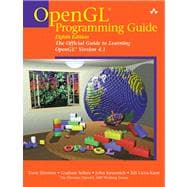
What is included with this book?
Dave Shreiner (Mountain View, CA) has contributed to the last six editions of The OpenGL Programming Guide , and has been active in OpenGL's development nearly since its inception. He is the author of the first commercial OpenGL training course, and has presented courses on OpenGL programming world-wide for the last two decades. He is currently Director of graphics and GPU computing at ARM, Inc.
Graham Sellers (Oviedo, FL), co-author of the OpenGL SuperBible is Manager of OpenGL Software Development at AMD. He is the author of many OpenGL feature specifications, and has contributed to bring OpenGL ES to desktop computers.
John Kessenich (Fort Collins, CO), is the OpenGL Shading Language specification editor, and is currently a consultant at LunarG, Inc. building compiler technology for GLSL. Previously, he helped develop OpenGL 2.0 and OpenGL ES 2.0 while at 3Dlabs, and continued working on OpenGL standards as a Principal Engineer at Intel.
Bill Licea-Kane (Arlington, MA), co-author of the OpenGL Shading Language Guide , is a Principal Member of the Technical Staff at AMD, where he guides OpenGL architect. He also chairs the OpenGL Shading Language technical sub-group in the OpenGL ARB, and has also presented courses on OpenGL at SIGGRAPH and other conferences.
Chapter 2: Shader Fundamentals
Chapter 3: Drawing with OpenGL
Chapter 4: Color
Chapter 5: Viewing, Transformations, and Clipping
Chapter 6: Texture Mapping
Chapter 7: Framebuffers
Chapter 8: Light, Shadow, and Atmospheric Effects
Chapter 9: Tessellation Shaders
Chapter 10: Geometry Shaders
Chapter 11: Memory
Appendix A: Basics of GLUT: The OpenGL Utility Toolkit
Appendix B: OpenGL ES Compatibility
Appendix C: Built-in OpenGL Shading Language Variables and Functions
Appendix D: State Variables
Appendix E: Homogenous Coordinates and Transformation Matrices
Appendix F: OpenGL, Window Systems, and Language Bindings
Appendix G: Floating-Point Formats for Textures, Framebuffers, and Renderbuffers
Appendix H: Compressed Texture Formats
Appendix I: std140Uniform Buffer Layout
The New copy of this book will include any supplemental materials advertised. Please check the title of the book to determine if it should include any access cards, study guides, lab manuals, CDs, etc.
The Used, Rental and eBook copies of this book are not guaranteed to include any supplemental materials. Typically, only the book itself is included. This is true even if the title states it includes any access cards, study guides, lab manuals, CDs, etc.